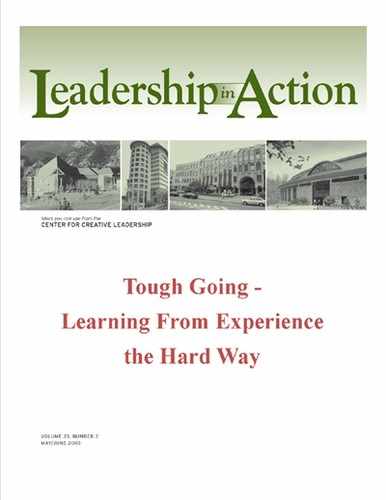Tough Going: Learning from Experience the Hard Way
by Russ S. Moxley and Mary Lynn Pulley

No one would ever choose to experience a hardship, but leaders say that difficult times are often key events in their development. Hardships can make people more aware of their values, their aspirations, and themselves. Here's a look at six types of hardship events and the lessons executives can take from these events to make themselves better leaders.
A high-powered executive we know says that he learned the most valuable lessons about how he functions as a leader not from his serial successes but rather from the hardships he encountered along the way. By his own account, Jim had become arrogant. He thought he could do it all. He didn't need to delegate. Then he had a heart attack. When he returned to work, Jim had to learn to delegate better and not be so driven and self-centered. He had to balance self-confidence with humility. In the process he became a more well-rounded leader. He was able to act with flexibility, maintaining confidence in his own judgment but also relying on the judgment of others.
One of the surprising findings from CCL's research is the extent to which hardships are important to the development of well-rounded leaders. In CCL's most recent research on the lessons of experience, leaders mentioned hardship more than any other experience as a key event in their development. The research also found that hardships differ from other developmental experiences because they are not intentional—people encounter them naturally during the course of their careers and their lives. The challenges embedded in hardships are also different from those found in other kinds of developmental experiences. In addition, hardships provide some very specific—though hard-won—lessons about self-knowledge, sensitivity, control, and flexibility. A sense of loss accompanies every hardship, and it is this sense of loss that to some extent seems to drive learning.
Hardships often serve as wake-up calls. People decide what really matters, become more clear about their values and career aspirations, and develop greater self-awareness. They recognize, perhaps for the first time, that they have limits. They also become aware of their blind spots—things others have known about them but they themselves have not. Hardships can move people toward a more appropriate balance between their work and their family life.
Being sensitive and compassionate is often seen as the “soft side” of leadership. Sensitivity and compassion are valuable attributes for everyone, in personal life and work. Yet many people, especially those who hold positions of power and authority, find it difficult to express sensitivity and compassion. Showing vulnerability in the workplace can be a frightening proposition because it means that people must stop masking, denying, or avoiding their own or other people's pain. Even though leaders may feel compassion toward a person or situation, they often suppress these sensitive feelings due to the common belief that they are inappropriate in the workplace. Often it is when leaders experience a personal hardship that they learn the importance of sensitivity toward others, become more aware of the fears and hopes of others, and decide to be more vulnerable.
The sense of having personal control over one's environment and destiny is generally associated with high motivation and achievement. This internal locus of control flows from the idea that the rewards one receives are contingent upon one's actions or attributes. Yet events do conspire; no one can control everything. Hardships often teach people the limits of their control. From hardships leaders can learn that the more balanced perspective is the ability to accurately determine what is and is not within their control while recognizing that everyone has limits to his or her control. And they can learn that their greatest realm of control is not over situations themselves but over how they will respond to situations or hardships as they occur.
The traditional view is that a healthy personal identity is characterized by stability and constancy. But today change is so prodigious that this model is no longer as functional as an identity constructed of multiple involvements, images, and skills that allow the individual to adapt to changing circumstances. This is one definition of flexibility. In addition, people have often thought they had to be either-or: either tough or soft, self-confident or humble, a strong individual leader or a good team player. But another idea of flexibility suggests that a key lesson individuals can learn from hardships is that they can be both-and.
The question is not whether mistakes will be made but whether they are seen as opportunities to learn.
